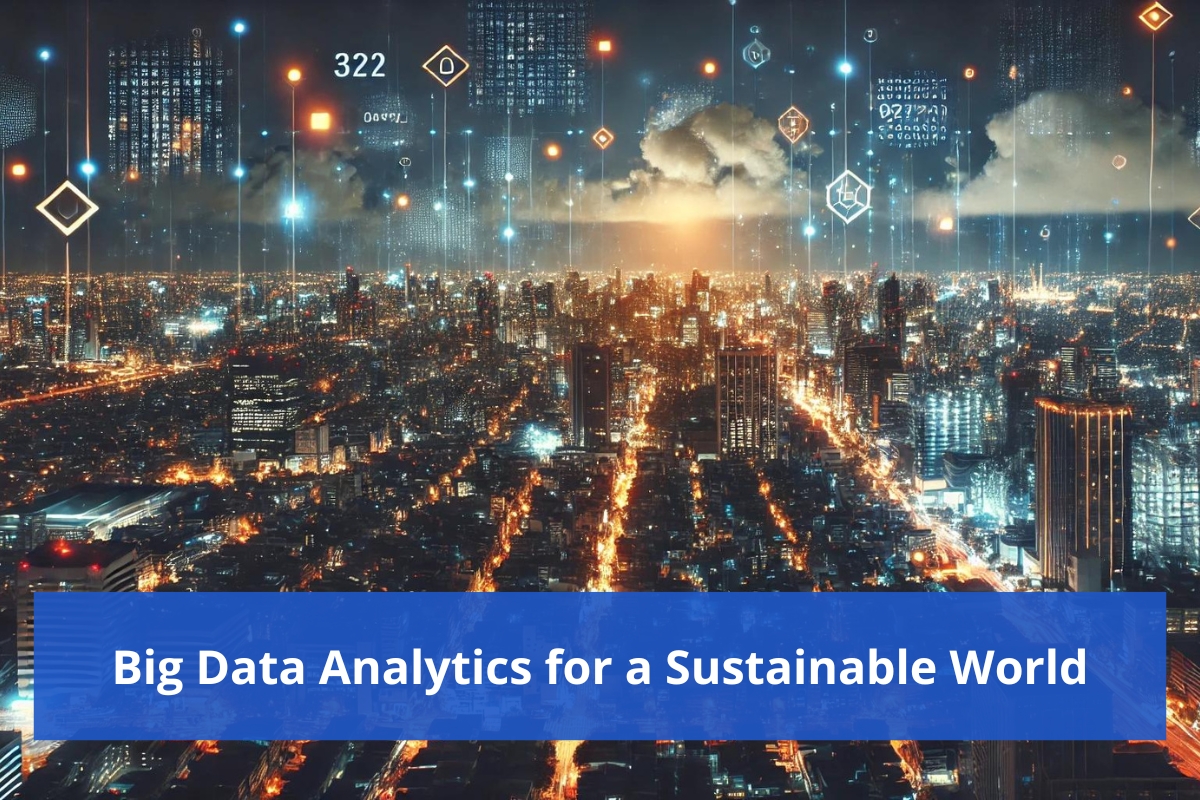As the need for environmental protection is becoming a major concern among the world population, various businesses around the globe are looking for means to modify their operations in a more eco-friendly manner. One of the most useful strategies that they have in their arsenal is the use of big data.
Through the power of big data analytics, organizations can pinpoint areas where they can adopt less harmful practices, improve their supply chain, and utilize data to make rational decisions beneficial for the environment. This section seeks to explain why big data should be embraced for the sake of environmental protection and describes practices that can be employed by businesses in order to do so.
Understanding Big Data and Its Role in Environmental Protection
IoT devices, social networks, customers and transactional data generate extremely huge amounts of data that consists of both structured and unstructured volumes and patterns. However, if such information is correctly reviewed, it can tell a lot about the company including its sustainability. Big data analytics is processing of these big and complex data sets to identify patterns relationships or trends which help a business make certain business decisions.
Big Data enables companies to control and wipe out their carbon footprints, efficient management of resources, and provide predictions on future threats to the environment, which are valuable in the sustainability practices of businesses. This has led to more pm and phosphorous free elucidation of activities with widgets incorporating advanced information analysis tools for businesses to be more responsible to their environment and improve on the said ways.
Big Data for Reducing Carbon Footprint
Indeed, one of the most remarkable aspects of the big data application in environmental protection is the extent to which it can assist organizations to cut their carbon emissions. Carbon footprint is the total amount of Greenhouse Gas (GHG) emitted, either directly or indirectly, by an organization, product, or activity. With the use of big data analytics, GHG emissions for most companies can easily be captured by examining how much energy is utilized, how resources are transported and the processes that manufacture their products and goods.
Focusing attention on emission hotspots enables organizations to carry out targeted emission reduction efforts. For instance, using auxiliary devices such as predictive maintenance, which relies on data from sensors and IOT devices to predict when a piece of equipment will break and when to repair it, management can cut down energy expenditure within their premises. This has the merits of decreasing both the energy wastage and maintenance and downtime costs.
Similarly, companies can leverage big data to improve the efficiency levels of their transportation and logistics infrastructure. By evaluating factors like the amount of fuel used, the efficiencies of different routes and their respective delivery times, the businesses can be able to construct green logistics that are efficient in emissions and other transport costs.
Improving Supply Chain Efficiency with Big Data
Supply chain processes tend to remain one of the biggest determinants of a company’s carbon footprint. There are undertakings done in trade secret beginning from the mining of raw materials to the distribution of finished goods that causes adverse environmental pollution. All these processes can fully utilize big data to manage supply chain activities that are more effective and greener.
With big data, companies are able to evaluate the processes engaged within the different stages of the chain with the view of eliminating wastages, economizing of resources and even cutting emissions. For instance, organizations need to employ skilled data analysts for the purposes of forecasting demand and for managing inventories in order to limit transportation and warehousing economies. They are also able to evaluate historical data concerning the conduct of suppliers and select sustainable suppliers.
Moreover, the information provided by big data allows the organization to break linear consumption models and move toward a more circular design of the product, which prevents waste and conserves resources by making sure that the product can be reused, recycled or upcycled in anyway possible. Resource efficiency and waste prevention strategies can be created by the enterprises based on data concerning product lifecycle, materials employed, and customer activity.
Predictive Insights for Proactive Environmental Management
In addition, becausse of the advantage that big data is more detailed than small data, forecasting what might happen concerning an organization’s environment is a possibility owing to data with multiple facets. Predictive analysis encompasses the examination of historical data, application of machine learning techniques, and formulation of statistical models in predicting the likely outcomes in the future. When it comes to environment protection, predictive analysis can be employed to predict the changes, risks that may occur in the environment and prevent such
For example, organizations can perform predictive analysis to estimate the level of pollution that would be released to the environment as a result of the activities or projects in question even before they are done. Using this method, companies can simulate different scenarios in order to understand what problems may arise and try to deal with them in a way that will avoid causing environmental damage. This method is effective in construction, mining industries and manufacturing industries where many activities carried out are environmentally invasive.
In addition, it attests to the accuracy and reliability of the weather forecasting application. On the other hand, companies can make use of scored measurements in design by evaluating ways of minimizing the risks associated with with the physical site of their logistical activities. Such level of readiness does not only contribute to environmental preservation but also guarantees the normal operations of the business.
Utilizing Big Data in the Forecast of Sustainably Oriented Product Development
There is a noticeable tilt in consumers’ choices and the behavior of the market towards sustainability. Nowadays, more customers are searching for greener products and services that suit their principles. In terms of data, it can highlight trends in consumer behaviour which could assist firms in designing more eco-friendly products that cater to the needs of its consumers.
Businesses can track customer social media, staging of product launch by getting running reviews as well as tracking opinions of the g and s product and new clients on the board examining their Washington areas concerns and opinions trending oriented towards green. This insight can be used to develop not only green products but green products that are suitable for the corresponding consumers. Moreover, companies can use big data to create effective advertising promotions which based on the consumer market and their consciousness of “green” features of their product enhancing the prevalence of a brand and expanding the market.
Ethical Issues Associated with Big Data Collection and Analysis
Although it has been discussed that big data can be very useful for conservation, companies need to reflect on their data collection and analysis practices in an ethical manner. The use of data always raises issues of privacy and security especially when it comes to personally identifiable information or any other sensitive information. Organizations are obliged to follow some data protection management systems such as the GDPR or CCPA so as to protect their customers’ personal information.
As well, organizations will have to inform potential concerns about some patterns in the data sets they use. Such patterns may arise from the way the data was collected, who the respondents were, and even how an algorithm patterns the results. Failure to eliminate such biases could result in making wrong conclusions and making the wrong choices. To avoid the stated problems, companies therefore need to intend to apply proper data stewardship policies, engage different orientation and perspectives during data evaluation, and evaluate their findings periodically and objectively.
Best Strategies to Improve Big Data Optimization for Environmental Issues
In order to utilize big data for environmental concerns, organizations need to implement the following best practices:
Establish a Data Strategy
Prior to getting into the business of big data analytics, the company should create a proper data strategy that converges with its environmental targets. The scope of this strategy should be to define “what” is expected, “how” data collection, analysis, and reporting will be performed, and “why” it will be performed.
Purchase Advanced Analytics Tools
Advancing in analytical tools and technologies is necessary for meeting the core goal of any business by optimizing the use and management of big data. Data collection and processing capabilities can be heightened by mobile IoT devices, cloud-based platforms and machine learning algorithms, thus culminating in quicker monitoring and evaluation of environmental performance.
Work with Peripherals
Employees, suppliers, customers, and regulators of business must be presented with the various data analytics addressing strategies, this is to ensure that irrespective of the existing data, decisions made will not detract from the environment or societies. This will foster collaboration that assists to pinpoint risks and possibilities for sustainability.
Be Conscious of Data Quality
What constitutes big data analytics is the accurate analysis of large volumes of data. In line with this, it is important for organizations to have strong data governance policies in place that will help manage accuracy, consistency, and reliability of the data and so eliminate the chances of incorrect analysis.
Monitor and Measure Impact
Consistently gauge and assess these data driven strategies’ effects on the performance of environment over time. Develop key performance indicators (KPIs) which can help evaluate the adopters’ progress over time.
The conclusion
This is a great approach for companies that allows them to earn revenues from environmental protection rather than incur costs promoting it. Thanks to data and prediction mechanisms, companies will know and control their environment, with far advanced strategies and decisions, which are hardly possible in the current society or are just utopia.
But to take advantage of these opportunities, companies have to implement certain requirements on data gathering, processing and management in a focused way which promotes ethical and environmental concerns. In this way, they will be able to contribute to environmental outcomes successfully while being successful in business themselves.



